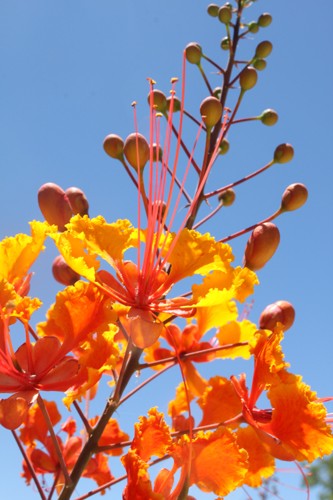One of the largest of its species in the Western Hemisphere, a tall baobab tree decorates the southwest corner of the Administration building with its colorful orange flowers. This unique specimen is one of the 8,000 trees that make up the UA Campus Arboretum, which was named a 2010 Tree Campus USA by the National Arbor Day Foundation and Toyota.
“”The trees aren’t like the normal trees you see in the desert, which gives UA the feel of not being in Tucson. Not seeing the mountains, seeing all the grass and trees — it’s a change from the dirt and dead trees outside of campus. You can always look forward to going back to a nice, green campus,”” said Rachel Svetlik, a UA sophomore.
Junior Taylor-Rose Olea appreciates the greenery as well.
“”I especially like the Mall area with all the palm trees and green. I like the area on the west side of campus, between Park and the CESL building. It’s so shady and cool,”” Olea said.
The diversity of plants and trees providing the shade and splendor around campus includes more than 400 different species, according to UA Arboretum director Libby Davidson.
The Arboretum website gives a detailed map, locating each plant and tree on campus. Photos are provided as identification, and a “”What’s in Bloom”” link showcases specific seasons’ plants and trees. There are also lists of important trees, tree walks and historical information.
In 1999, the first committee meeting established the Arboretum, but Davidson said they had somewhat of a grand opening in 2002.
“”Everyone that came to the table at the first meeting were plant people. We knew there were a lot of unique trees and that we needed to document them,”” Davidson said.
Davidson, faculty and staff, students, members of the biology and plant science departments and many more make up the UA Arboretum crew.
The Arboretum makes its money through memberships, donations and gifts. Donors can earn a bench with their name on it or adopt a tree.
According to the Arboretum’s website, its goal is to protect and enhance this collection, as well as fully utilize the benefits of outdoor education.
“”Students will do projects, independent study, class activities and more,”” Davidson said.
Even if UA students are unaware of the Arboretum, they cannot miss the beauty of the campus.
“”There’s this area with a walkway with two rows of orange trees across from Centennial Hall. It’s really shaded and pretty when it’s in bloom. It’s my favorite place. Sometimes I just sit there, and sometimes I’ll take a different way to class to pass them. Also, if I have time in between classes, I like to walk around campus and look at all the trees,”” said Caitlin Ocheltree, a junior.
While the scenic campus is enjoyable, sometimes taking care of the plants and trees is not.
Facilities Management ground services tend them all on a daily basis.
“”About 50 to 60 people of ground crew are all trained as horticulturists. They look at the plants’ area and decide if there are diseases or not,”” Davidson said.
Unfortunately, they spend a little more time picking up garbage than working on the actual plants, she added.
“”They are skilled people who would rather be looking at plants than picking up trash,”” Davidson said.
Davidson estimates that about 20 trees are taken down annually for reasons such as construction or damage.
Preservation and protection are important to keep the Arboretum alive and well. Davidson said a good example is the big eucalyptus across from the Student Recreation Center, located in the middle of a construction zone, that is protected by a fence.
“”The effort to protect this would not have happened before the Arboretum became active,”” Davidson said.
While some students may take these efforts for granted, others truly appreciate being outside at the UA.
“”I took a field science class for two years in high school, which made me appreciate being outside and the campus. I’ve danced at the UA and we’ve done class and yoga outside, which is really nice,”” said Allyna Sanchez, a sophomore.









